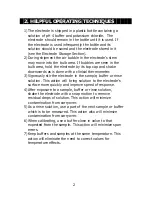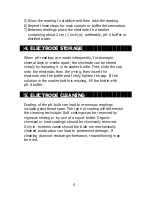
8)pH readings stabilize faster in some solutions than others;
allow time for the reading to stabilize. In general, buffers
provide stable readings in several seconds (tris buffers
take somewhat longer) while samples usually take longer
times.
9)Keep in mind that all pH electrodes age with time. Aging
is characterized by shortened span and slower speed of
response. If the meter has a manual or microprocessor
slope (span) control, the control can be adjusted to
compensate for electrode span errors ( but will not effect
the speed of response ). Aging is best detected by
calibrating the electrode in, for example, 7 buffer, then
rinsing and placing the electrode in 4 buffer. As a rule, if
the span is 10 % or more in error (a reading of 4.3 or
higher for this example) the electrode should be cleaned and
retested (see the Electrode Cleaning Section) or
reconditioned ( see the Reconditioning Section ).
If performance is not restored the electrode should be
replaced.
3. CALIBRATION AND MEASUREMENTS
As a rule, follow the procedures recommended by the pH
Meter manufacturer keeping in mind the Helpful Operating
Techniques given above. The frequency of calibration is a
function of the electrode, the pH meter and the solutions
the electro measurements :
1)Remove the electrode form its soaker bottle and save the
bottle.
2)Vigorously stir the electrode in a rinse solution.
3)Shake the electrode with a snap action to remove residual
drops of solution.
4)Vigorously stir the electrode in the buffer or sample and
allow the electrode to rest against the beaker's wall.
3







